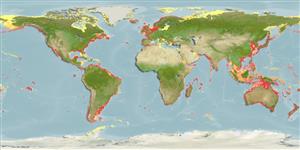Common names from other countries
Environment: milieu / climate zone / depth range / distribution range
Sinh thái học
; Mức độ sâu 0 - 80 m (Ref. 1603). Tropical; 68°N - 76°S, 180°W - 180°E
Circumglobal.
Length at first maturity / Bộ gần gũi / Khối lượng (Trọng lượng) / Age
Maturity: Lm ? range ? - ? cm Max length : 0.1 cm TL con đực/không giới tính; (Ref. 2226)
Assumed maximum length of zooids from Ref. 2226. Found also on dead corals. Attached to hard substrata (Ref. 1603); from low water level (Ref. 226) to depth of about 80 m (Ref. 1603); occurs in mangrove ponds (Ref. 1758). Colonial (Ref. 415).
Life cycle and mating behavior
Chín muồi sinh dục | Sự tái sinh sản | Đẻ trứng | Các trứng | Sự sinh sản | Ấu trùng
Members of the class Ascidiacea are hermaphroditic; both cross- and self-fertilization is typical. Life cycle: Eggs develop into lecithotrophic larva before metamorphosing into benthic adults.
Sanamyan, K. and D. Schories. 2004. (Ref. 3379)
IUCN Red List Status (Ref. 130435)
CITES status (Ref. 108899)
Not Evaluated
Not Evaluated
Human uses
| FishSource |
Các công cụ
Thêm thông tin
Age/SizeSự sinh trưởngLength-weightLength-lengthHình thái họcẤu trùngSự phong phú
Các nguồn internet
Estimates based on models
Preferred temperature
(Ref.
115969): 7.3 - 27.9, mean 18.3 (based on 3200 cells).
Vulnerability
Low vulnerability (10 of 100).
Price category
Unknown.
